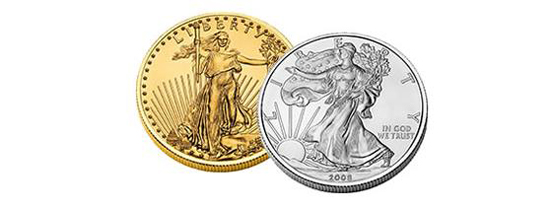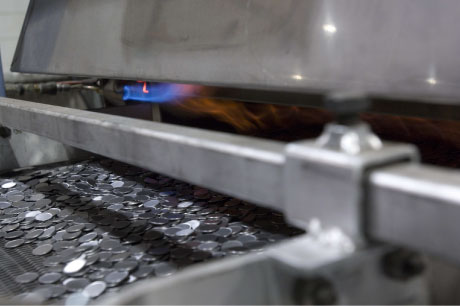Machines are used in the production of silver or gold coins
Production of silver coins involves the use of multiple machines including foundry machinery such as casters and furnaces, extruders and milling machines, breakdown rolls, annealers, finish rolls, blanking presses, rimming and burnishing machines.
Foundry Machinery and Extruding Machines
First, the raw silver or gold needs to be melted down in the foundry using a high frequency, electric coil furnace. The molten metal can either be manually poured into a graphite mold or poured into a caster which holds the molten metal to be pulled through a graphite mold, also known as a continuous casting machine. The result is a bar or circular billet of silver or gold.
The next process involves the heating up of billets in an oven which are then pushed through a steel die by a powerful hydraulic ram which extrudes the softened metal into strip form. If the metal is already in strip form, then it will go to a milling machine instead which is used to remove the surface layer of the bar to achieve the desired uniform thickness. Then the corner edges are deburred using manual tools or an automatic deburring machine.
Rolling Mill and Annealing Machines
Once silver or gold bars or strips of the desired thickness are ready, they are sent to an annealed which is a large machine with a conveyer in which the precious metal bars are placed. The silver and gold bars or strips go through several internal temperature controlled chambers which heat the metal up and cool it down in order to bring the metal to a specific hardness.
Now, the silver and gold bars are ready to go through a breakdown rolling mill consisting of a set of adjustable double steel rollers used to reduce the thickness of the bars to a specific thickness in preparation for the next process. Typically, bars and strips will have to be passed through 2 or more times, each time adjusting the rollers down, to reduce the thickness in small increments since the hardness of the metal is being affected and rolling the bars too quickly will cause the bars to be too hard for further processes.
Next, the silver and gold bars are ready to return to the annealing machine to be softened to a specific hardness. They are run through the oven and cooling sections of the annealer, then checked for accurate hardness and returned through the annealer, if needed, to achieve the desired hardness.
The next machine is another rolling mill called the finish roller. The finish rolling mill is used similar to that of the breakdown rollers accept the silver and gold bars are now reduced down to their final thickness, which is going to be the thickness of the coin. This typically takes 2 or more passes through the milling machine rollers to ensure the hardness of the metal is not too hard for the next process.
Punches and Hydraulic Presses
Once the bars are the desired thickness, they are ready to be punched into coins using a hydraulic press. In mass production of coins, the press will be set to automatically punch in which the strips are manually fed into the machine by an operator. A set of conveyers is used to move the punched coins to be weighed, inspected, and stacked onto a cart for the next processes.
Next, the blanked coins need to be placed into a rimming machine which is a spinning circular apparatus with an outer wall used to add the raised edge around the parameter of the coin. This process can be completed as part of the conveyer system immediately after being blanked in the hydraulic press; the conveyer can feed the blank coins into the rimming machine.
The final processes include burnishing in which the coins are placed into burnishing machines or tumblers with steel media that looks similar to that of misshapen BB


Making millions of coins every day is a complex process. People and machines have to work together smoothly. A tour through the United States Mint at Philadelphia or Denver to witness this process is well worth the visit. Blanks are punched from coiled strips of metal about 13 inches by 1,500 feet in a blanking press. The leftover webbing is chopped up and recycled. The cent is the only coin stamped onto pre-made blanks.
Coin minting can be considered an art form, in as much as collecting them is. It is actually like making a sculpture, starting from the conceptualization of the design up to the actual striking process. It all starts with the development of sketches for the coin design. The minthas several sculptors in employ, who create one set of sketches for each commissioned coin. From this set, the mint will choose and approve one sketch. Then the sculptor will create a clay model several times larger than the real coin.